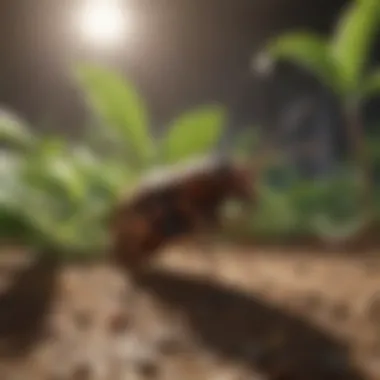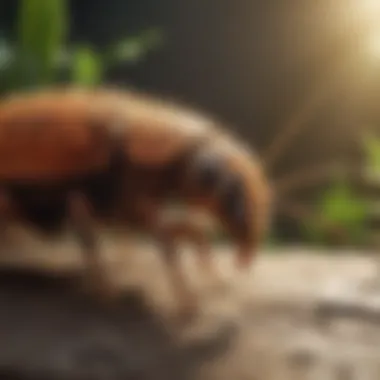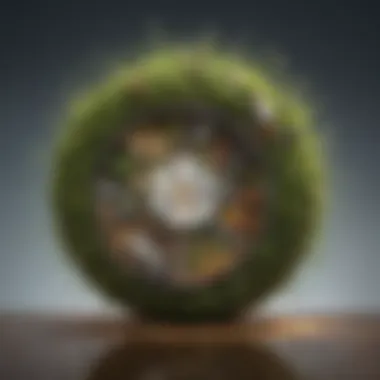Pro Staff Termite and Pest Control Solutions


Intro
Understanding Pests
Definition of Pests
Pests are organisms that can cause harm to health, property, or the environment. They can range from insects, such as termites and ants, to larger critters like rodents. Certain plants can also be considered pests if they disrupt garden ecosystems.
Importance of Pest Identification
Identifying the specific type of pest is essential before implementing control measures. Different pests have unique behaviors and vulnerabilities, which can greatly influence the choice of treatment. For example, the strategies used to control termites differ markedly from those for cockroaches. Proper identification helps in applying targeted treatments, thus enhancing effectiveness and minimizing chemical use.
Prevention Techniques
Home and Garden Preventative Measures
Effective pest management begins with prevention. Homeowners should take specific steps to reduce the chances of pest infestation:
- Seal Cracks and Holes: Inspect your property for gaps in walls, windows, and foundations.
- Proper Waste Management: Keep garbage sealed and dispose of food waste promptly.
- Maintain Landscaping: Trim bushes and trees to reduce shelter during pest movement.
Seasonal Prevention Tips
Pests can be seasonal, which means understanding their lifecycle is crucial. Spring often sees an uptick in certain pests, while others may be more prevalent in the fall.
- Spring: Inspect for termites as they swarm during this season.
- Summer: Ensure that outdoor plants are well-watered but not over-saturated, preventing mosquito breeding.
- Fall/Winter: Check for entry points and seal them to keep rodents out during colder months.
Eco-Friendly Pest Control Solutions
Overview of Sustainable Practices
Sustainable pest control focuses on methods that minimize environmental impact. Integrated Pest Management (IPM) is one such approach that emphasizes monitoring and managing pest populations using less toxic strategies.
Natural Remedies and Their Effectiveness
Many homeowners seek alternatives to chemical treatments. Here are some common natural remedies that can be effective:
- Diatomaceous Earth: A natural powder that can help control insects like cockroaches and ants.
- Essential Oils: Certain oils, such as peppermint or tea tree oil, can deter pests.
- Vinegar Solutions: A mixture of vinegar and water can serve as a repellent for various insects.
"Understanding and integrating sustainable pest control practices is vital for both human health and environmental conservation."
Understanding Termite and Pest Control
Understanding termite and pest control is crucial for maintaining a safe and comfortable living environment. This article addresses various aspects of pest management, providing a foundation for homeowners to approach the topic with knowledge and confidence. Effective pest control strategies not only safeguard homes but also contribute to overall health and well-being.
Definition and Scope
Termite and pest control encompasses a range of practices aimed at eliminating pests and preventing their return. This includes strategies designed specifically for termites, which can cause severe structural damage, and broader pest categories that can affect hygiene and comfort. Definitions vary as pest management can include chemical, biological, and physical methods. The scope is broad, aiming to cover immediate pest extermination alongside long-term control practices.
The intersection of pest control with ecological considerations also forms part of this scope, directing attention toward methods that are less harmful to the environment. Homeowners must understand these definitions to engage in informed discussions and make educated choices about professionals or products they wish to employ.
Importance in Home Management
The importance of termite and pest control in home management cannot be overstated. For homeowners, understanding when and how to act upon pest issues is key to prevention and intervention. First, undrstanding pests protects properties from potential damage. Termites, often termed the "silent destroyers", can severely undermine structural integrity before homeowners even notice a problem. Proactive control measures can mitigate such risks.
Second, pest control plays a role in maintaining the health of the household. Pests such as rodents or cockroaches can introduce allergens or diseases. An effective pest management strategy includes monitoring and addressing issues before they escalate.
Lastly, integrating pest control into regular home maintenance routines contributes to peace of mind. Knowing that your home is safeguarded against infestations allows families to focus on their daily lives rather than worrying about potential pest problems.
"Effective pest management is not just about extermination, it’s about sustained prevention and ensuring a healthy living environment."


In summary, comprehending the significance of termite and pest control will empower homeowners to undertake informed measures to protect their properties and loved ones.
The Role of Pro Staff in Pest Control
Understanding the role of professional staff in pest control is crucial for homeowners seeking effective solutions against infestations. With expertise and knowledge, professional pest control teams, often referred to as Pro Staff, offer a range of services that go beyond basic remedies. They ensure that the approaches taken are scientifically sound and tailored to specific pest problems, whether they are termites, ants, or rodents.
Pro Staff employ rigorous training and comprehensive methodologies to address pest control issues. Their significance lies not just in extermination, but in prevention, identification, and treatment. Their work can save time and money for homeowners, while offering peace of mind through guaranteed results and lower likelihood of recurrence.
Qualifications and Training
Pro Staff in pest control possess a variety of qualifications that enable them to perform their duties competently. Many start with a background in biology, environmental science, or agriculture. This foundational knowledge allows them to understand pest behaviors and interactions with their environment.
Additionally, technicians often undergo specialized training, which can include:
- Certification Programs: Many regions require pest control professionals to complete certification programs that cover local regulations, pest identification, and treatment methods.
- Continuous Education: Staying updated on the latest methods and regulations is critical. This may involve attending workshops or pursuing additional certifications.
- On-the-Job Training: Practical experience is gained through apprenticeships or training under experienced professionals, enhancing their skills in real-world scenarios.
The combination of formal education and hands-on experience equips Pro Staff with robust skills applicable to a range of situations that homeowners may encounter.
Expertise in Identification and Treatment
The ability to identify various pest species efficiently is a cornerstone of what Pro Staff bring to the table. Not every pest problem is equal, and their tactics will vary significantly depending on the species involved. For instance, the methods used for termite removal differ greatly from those required for managing mice or cockroaches.
Pro Staff leverage their expertise to:
- Diagnose: They assess the extent of infestations, checking for signs such as droppings, nests, or damage to structures.
- Recommend Treatment Plan: Based on their diagnosis, they create a tailored treatment plan considering the health of inhabitants and environmental impacts.
- Implement Control Measures: This may include chemical treatments, traps, or habitat modification to eliminate the pests effectively, ensuring minimal disruption to the household.
The depth of knowledge possessed by Pro Staff leads to effective and efficient pest control solutions that minimize risks to human health and the environment.
In summary, professional staff play a pivotal role in pest management, combining qualifications, training, and a wealth of experience to safeguard homes from infestations. This commitment to excellence ensures that when homeowners call upon their services, they receive not only treatment but also education on best practices for prevention.
Common Pests Addressed by Pro Staff
Understanding the common pests encountered in residential environments is essential for homeowners and those involved in pest management. Pro Staff focuses on identifying and addressing these pests effectively. This knowledge aids in the development of tailored pest control strategies. Homeowners can benefit from knowing which pests might affect their property and how to manage them.
Termite Species and Behavior
Termites are among the most destructive pests affecting homes. There are several species, but Subterranean, Drywood, and Dampwood termites are the most common.
Subterranean termites build colonies underground. They are notorious for causing severe damage to wooden structures. Their diet primarily consists of cellulose, which is abundant in wood. They travel to the surface through mud tubes, making their presence hard to detect until significant damage occurs.
Drywood termites live inside the wood they consume. They do not require contact with the ground, making them harder to spot. These termites leave behind small pellets of fecal matter. Homeowners might notice these when they see signs of infestation.
Dampwood termites are attracted to moist wood. This species often infests structures with water damage. Treating moisture issues is essential in controlling these pests effectively.
Understanding the behavior of these termites is crucial. They reproduce quickly, and their colonies can grow large within a short period.
Other Frequent Pests
Apart from termites, Pro Staff addresses several other common pests found in homes:
- Ants: Ants can invade homes seeking food. Different species, such as carpenter ants, can cause structural damage.
- Cockroaches: These pests thrive in dark, warm places. They are notorious for carrying diseases. Their presence signifies poor sanitation.
- Rodents: Mice and rats can carry various diseases and can damage property by gnawing on wires and insulation.
- Bed Bugs: These pests are stubborn to eliminate. They feed on human blood, leading to discomfort and sleep loss.
Identifying these pests early is vital in pest management. Pro Staff employs trained specialists to detect the signs of infestations, enabling timely intervention and effective pest control strategies.
Pest Control Methodologies
The topic of pest control methodologies is essential in understanding how experts like Pro Staff effectively manage infestations. Each method holds distinct characteristics and benefits. Methodologies encompass chemical treatments, biological control methods, and physical removal techniques. Knowing these approaches provides homeowners a clearer view of pest management strategies. Choosing the appropriate method can lead to effective results, minimizing risks to health and property.
Chemical Treatments
Chemical treatments are one of the most common approaches in pest control. These involve the use of synthetic or natural substances, designed to eliminate or repel pests. When applied correctly, they can quickly reduce large pest populations. Key benefits of chemical treatments include:


- Speed of Action: Chemical solutions often provide rapid results, making them ideal for urgent situations.
- Target Specificity: Many chemical agents are formulated to target specific pest species, reducing collateral impact on non-target species.
- Long-Lasting Effects: Some chemical treatments establish a residual effect, offering prolonged protection against future infestations.
However, it is critical to consider potential downsides. Incorrect usage can lead to health risks for humans and pets. Furthermore, it can contribute to chemical resistance in pest populations. Homeowners should consult with professionals to ensure safe and effective application of chemical treatments.
Biological Control Methods
Biological control methods employ living organisms to manage pest populations. This can include predators, parasites, or pathogens that naturally reduce pest numbers. Benefits of biological control are numerous, including:
- Environmentally Friendly: Since these methods utilize natural processes, they tend to be more eco-friendly compared to chemical treatments.
- Sustainability: Biological control often results in long-term solutions without the drawbacks of chemical residues.
- Pest Population Management: By disrupting the pest life cycle, this method can keep populations at manageable levels.
Examples of biological controls include using ladybugs to manage aphid populations or introducing nematodes to combat grubs in lawn care. Homeowners interested in sustainable practices may favor these methods, as they align with a more holistic approach to pest management.
Physical Removal Techniques
Physical removal techniques involve methods that physically eliminate pests without the use of chemicals. These strategies can consist of traps, barriers, or manual removal. Some significant aspects include:
- Immediate Impact: Physical methods can provide immediate relief from a pest problem, especially when quick action is required.
- Low Environmental Impact: These methods do not introduce chemicals into the home environment, making them safer for occupants.
- Suitable for Smaller Infestations: Physical removal works well for minor infestations or specific areas.
Tools used in physical removal include traps for rodents and barriers to prevent termites from entering. While effective, these methods require diligence and monitoring to ensure they remain effective over time.
Understanding the different pest control methodologies allows homeowners to make informed decisions tailored to their specific infestations. It is crucial to choose wisely to maintain a balance between effective pest management and environmental considerations.
Integrated Pest Management Strategies
Integrated Pest Management (IPM) strategies represent a holistic approach to pest control, focusing not just on chemical solutions, but on a broader range of methods that consider pest biology and behavior. IPM is essential in today’s pest management landscape due to its emphasis on sustainability and environmental stewardship. Through the integration of multiple control methods, IPM reduces reliance on pesticides, ultimately lowering the risk of chemical exposure to humans and pets while ensuring effective pest management.
Preventive Measures
Preventive measures are the cornerstone of Integrated Pest Management. They aim to minimize the chances of pest infestations before they occur. Several tactics can be employed:
- Exclusion: Sealing entry points is critical. Small cracks and gaps in doors, windows, and foundations can serve as entryways for pests. Proper sealing techniques are an investment in preventing larger issues in the future.
- Sanitation: Maintaining clean living areas reduces attractants for pests. Regularly cleaning food storage areas, kitchens, and gardens minimizes pest populations.
- Lifestyle Adjustments: Making simple lifestyle changes can have a big impact. For instance, storing food in sealed containers and promptly cleaning spills can deter pests.
- Regular Inspections: Routine inspections allow homeowners to catch potential infestations early. This proactive measure can save time, money, and further complications down the line.
By focusing on these preventive practices, homeowners can create an environment that is less hospitable to pests.
Monitoring and Evaluation
Regular monitoring and evaluation form the backbone of any effective Integrated Pest Management strategy. They ensure that any pest activity is detected early and allows for informed decision-making. The key aspects include:
- Routine Pest Assessments: Regular checks for signs of pest activity—such as droppings, nests, or damage—are vital. This ongoing surveillance enables quick responses and adjustments to strategies when necessary.
- Trapping and Reports: Utilizing traps can provide quantitative data about pest populations. Analyzing trap results can help in understanding pest behavior and preferences.
- Evaluating Treatment Efficacy: After implementing control measures, it is important to assess their effectiveness. This step may involve further monitoring post-treatment to ensure that the methods employed are successful in managing pest populations.
"Evaluation is not an end but a crucial step in refining pest management strategies for the future."
Eco-Friendly Pest Control Solutions
The approach of eco-friendly pest control solutions is becoming increasingly important as awareness of environmental preservation rises. This section explores various sustainable practices and the role of natural predators in pest management. Each element underscores a balanced approach that minimizes harm to the ecosystem while achieving the desired pest control outcomes.
Sustainable Practices
Sustainable practices in pest control focus on long-term prevention methods rather than reactive measures. These practices aim to reduce the environmental footprint of pest management. They emphasize the use of non-toxic materials and the promotion of a healthy ecosystem. Some sustainable practices include:
- Habitat Management: Adjusting the landscape to make it less favorable for pests. This may involve proper lawn maintenance, plant selection, and drainage improvement.
- Organic Pesticides: Utilizing naturally derived compounds to control pests. These options often break down quickly and have lower toxicity for humans and pets.
- Preventive Measures: Regular inspections and maintenance can prevent infestations before they start. Homeowners can seal cracks, ensure proper ventilation, and reduce moisture to make their properties less inviting to pests.
By adopting these sustainable practices, homeowners not only contribute to the health of the environment but also safeguard their properties against pest infestations over the long-term.
The Role of Natural Predators
Natural predators serve a crucial role in controlling pest populations without the necessity for chemical interventions. This method aligns well with eco-friendly pest control, as it harnesses nature’s own mechanisms to keep pests at bay. Key aspects of this role include:
- Biodiversity Promotion: Introducing and preserving a variety of species within the ecosystem can enhance pest control. Ladybugs and lacewings, for example, are known to prey on aphids, dramatically reducing their numbers.
- Food Web Maintenance: Natural predators help maintain ecological balance by controlling pest populations. A disruption can lead to an overpopulation of pests, causing damage to the environment and property.
- Nontoxic Solutions: Relying on natural predators eliminates the need for chemical pest control methods. As a result, the risk of adverse effects on human health and the environment is minimized.


It is essential to recognize that fostering natural predators can lead to significant reductions in pest populations and promote a healthier living environment.
By leveraging both sustainable practices and the role of natural predators, homeowners can achieve effective pest control that respects and preserves the environment.
Health Considerations in Pest Control
Understanding health considerations in pest control is essential for homeowners and those involved in pest management. This section will discuss the various risks associated with pest control practices, the impact of pest management methods on human health, and the broader environmental consequences.
Human Health Risks
Pests can carry numerous disease-causing pathogens that affect human beings. Common nuisances such as rodents, cockroaches, and mosquitoes are notorious for spreading illnesses. For instance, rodents can transmit hantavirus and leptospirosis, while cockroaches are linked to respiratory issues, especially allergic reactions and asthma in children.
Furthermore, the chemicals used in pest control pose risks if mishandled. Pesticides, when applied improperly, can lead to exposure that may cause both short-term and long-lasting health effects. Symptoms could range from headaches and dizziness to more severe complications such as neurological impairments. It is vital for homeowners to choose pest control professionals, such as Pro Staff, who are trained to handle and apply these substances safely.
"Proper training and adherence to safety protocols minimize the risks associated with pest treatment and help ensure a healthy living environment."
Moreover, pregnant women, children, and individuals with compromised immune systems are particularly vulnerable to the adverse effects of chemicals and pest-borne diseases. Therefore, understanding potential health risks is crucial for informed pest management decisions.
Environmental Impact
The environmental ramifications of pest control methods cannot be overlooked. Chemicals used in pest control can leach into soil and waterways, harming aquatic ecosystems. Pesticides, particularly those that are non-biodegradable, can persist in the environment, leading to contamination that affects not just target pests but beneficial organisms too.
Chemical exposure can lead to the disruption of local biodiversity. Natural predators, which help control pest populations, may be affected indirectly through pesticide residue. This can create an imbalance that results in pest resurgence, necessitating even more chemical interventions—a cycle detrimental to both the environment and public health.
In contrast, eco-sensitive methods promote a healthier ecosystem. Utilizing integrated pest management strategies reduces chemical reliance and enhances the use of biological control agents, therefore offering a more sustainable solution to pest issues.
In summary, health considerations in pest control play a significant role in ensuring both effective management of pests and the safety of human health and the environment. Homeowners must remain vigilant, seeking sustainable solutions that minimize risks while effectively dealing with pest challenges.
The Future of Pest Control
Understanding the future of pest control is vital in shaping effective practices that not only manage pests but also promote a sustainable environment. With advancements in technology and an increasing awareness of ecological balance, the direction of pest management is continuously evolving. Homeowners are more concerned about the impacts of pest control methods, leading them to seek effective solutions that minimize chemical use and embrace integrated strategies. This evolution is essential for addressing growing pest resistance and fostering healthier living spaces.
Technological Innovations
Technological innovations are reshaping the pest control landscape. Intelligent systems, such as IoT devices, allow for real-time monitoring of pest activities. This enables pest control professionals to respond quickly and effectively, reducing the need for extensive chemical applications. Smart traps equipped with sensors can notify technicians when pests are detected, streamlining the eradication process.
Additionally, drones are being increasingly used for surveillance in large properties, making it easier to assess infestations without disturbing the environment. These advancements not only improve efficacy but also ensure that pest control practices are more environmentally responsible.
Key technological developments include:
- Smart traps and sensors: Provide instant data on pest movements.
- Drones for surveillance: Efficiently cover large areas for assessments.
- Data analytics: Personalizes pest control strategies based on historical data and trends.
"Technological innovation in pest control is not just about efficiency, it’s about changing how we think about pest management in a sustainable way."
Evolution of Pest Management Practices
The evolution of pest management practices reveals a significant shift from traditional methods to more integrated and eco-friendly approaches. This transition emphasizes the importance of preventive measures and ecological considerations.
Historically, pest control often relied heavily on broad-spectrum pesticides. However, there is now a clearer understanding of the potential human and environmental risks associated with these chemicals. As a result, integrated pest management (IPM) has gained traction, focusing on long-term prevention and control strategies.
Current practices in pest management include:
- Biological control: Utilizing natural predators to manage pest populations.
- Cultural practices: Modifying the environment to make it less conducive to pest infestations.
- Regular monitoring: Keeping track of pest populations and conditions that promote their growth.
The future includes a greater collaboration between technology and traditional practices, which is necessary to tackle the challenges posed by resistant pests and shifting ecological dynamics. As pest management practices continue to evolve, homeowners can look forward to more effective, targeted solutions that prioritize safety and sustainability.
Ending
Summary of Key Takeaways
In summary, the key points presented throughout this article include:
- The definition and scope of termite and pest control, emphasizing their relevance in home maintenance.
- The essential role of qualified professionals, such as those from Pro Staff, in the identification and treatment of pest issues.
- Insight into common pests, particularly termites, and their behaviors that necessitate prompt control measures.
- An overview of various pest control methodologies, including chemical, biological, and physical approaches.
- The integration of sustainable practices and eco-friendly solutions that align with modern environmental considerations.
- Recognition of health risks associated with pests and pest control measures, demanding careful planning and execution to minimize impact.
- The evolving landscape of pest management, highlighting the significance of technology and new methodologies in improving effectiveness.
Final Remarks on Pest Management
Pro Staff’s expertise ensures that pest management is conducted with precision, tailoring strategies to individual circumstances and promoting an understanding of pest ecology among homeowners. Encouraging ongoing education about pest control will empower individuals as they navigate the complexities of maintaining a pest-free environment.



